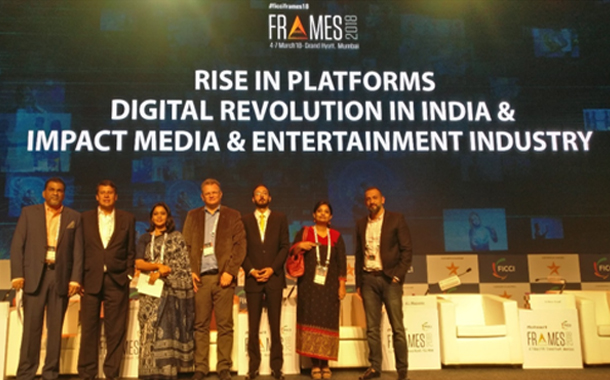With over a 100 OTT channels and platforms in India, FICCI Frames 2018 got together an interesting panel to discuss the Digital Revolution in India and its impact on the Media & Entertainment industry.
One of India’s foremost technocrats, broadcast networks veteran Vynsley Fernandes stepped in to moderate a panel comprising of Vivek Couto, Executive Director – Media Partners Asia, Vidya S Nath, Director – Frost & Sullivan, Michael Sturm, VP –Strategic Alliances & Channel Management – Verizon Digital Media, Suhaan Mukherji, Partner – PLRLaw, Ali Husseing, COO –Eros NOW and Archana Anand, EVP & Head of Digital – India, ZEE5 Business.
Sharing a positive sentiment, Archana Anand said that what the digital platforms have done is not eat into your TV time, but add to your viewing because you watch on the move. “The fight,” she said, is not about OTT versus TV, but for your time. It is fascinating, because we are consuming more.”
On the business size of such platforms, Anand said that in India, the language market is very underservedf, and there is tremendous business potential for “a platform that can serve (this need gap) with rich, language content”.
She said the fact that we are willing to watch movies at Rs 150 a ticket indicates a willingness to pay for good content. “Given that fact that we have both broadcast and an OTT platform,” Anand said “some new formats we create get monetized by TV too.”
Michael Sturm said desire to watch leads to willingness to pay. He said India is the home of content producers and produces the maximum content in the world. He said when Verizon Digital Media decided to enter India, “our mindset was, we have to do a deep evaluation to understand local trends; we couldn’t just copy-paste our previous international initiatives. We realised that India is not just about English and Hindi content, but has huge, enormous diversity.”
He said Verizon Digital Media services 10 local languages already for a partner’s service. Indicating it was important to serve the needs of every local ecosystem, Sturm said, “We allow extend to Indian partners no-capex-upfront and pay-as-you-go business models.”
Vivek Couto observed that there is a fundamental shift towards individual viewing. In Indonesia, the average watching time for OTT is 15 to 20 minutes individually. However in households – which is why Netflix has Set Top Box partnerships – it is 3 hours a day!”
He said the growth of OTT has deemocratised the field for confent cerators, especially local ones. “Of course, there is more than just video on OTT – like gaming, for instance,” he said.
The panel also touched upon an important aspect pertaining to the OTT space – that of regulation. Suhaan Mukherjisaid “you don’t know who your regulator is. The law has to define the regulation, and we have no definition of OTT. The only one, perhaps, is in the IT Act, in terms of intermediaries.”
Archana Anand said “regulation should look out for the consumer, but if it (regulation) is not progressive and futuristic, it becomes regressive. A balance is needed.” She said that while content like drugs-related and child porn content would be an obvious no-no, regulation for OTT should have a more liberal framework than that for traditional television, because content for the digital domain needs to be edgier.
Suhaan Mukherji said the issue would be about who is to be held responsible for content on the extreme edges, which would be frowned upon. He expected the National Telecom Policy to play an important role going ahead.
Vidya S Nath said, “Regulation does not always mean censorship. But if the government says ‘you can show a certain type of ads only after a specific time or late in the evenings, that needs to be re-examined.”
Archana Anand said, “Good, responsible self-regulation with (peer) consensus would help.”
Cable evangelist and industry veteran Ashok Mansukhani, MD & CEO – Hinduja (Media) Group, participating from the audience, said, “It is not that OTT is sexy and new and cable is old. Digital Cable & delivery systems will thrive and survive across the next 10 years and more. However, regulation must be fair to all. Should the OTT have only self-regulation, but cable continues to be regulated? Seems unfair.”
Vivek Couto cautioned that regulators should not go on to regulate other issues. He said price regulation should not be done (implying the need to support the fledgling and growing OTT Industry). “In Taiwan, price regulation happens with (traditional) Television, but they decided not to price-regulate OTT.”
All said and done, the OTT space seems poised to be the next enabler of growth in the M&E space through empowerment of the content production ecosystem, even as everyone in India seems to be consuming a content multiple pipelines of delivery. As every third panel had participants or moderators quoting Reed Hastings’ popular quote, “Netflix’s competition is with sleep.” Despite which, Netflix, per July 2017 headline, is reportedly ‘Bleeding Cash’ To The Tune Of $20 Billion And Growing.
But that’s another story.
Authored by: Yohan PC



















